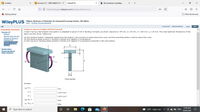
Elements Of Electromagnetics
7th Edition
ISBN: 9780190698614
Author: Sadiku, Matthew N. O.
Publisher: Oxford University Press
expand_more
expand_more
format_list_bulleted
Question
A beam having a tee-shaped cross section is subjected to equal 13 kN-m bending moments, as shown. Assume bf = 95 mm, tf = 25 mm, d = 165 mm, tw = 40 mm. The cross-sectional dimensions of the beam are also shown. Determine
(a) the centroid location (measured upward from the bottom), the moment of inertia about the z axis, and the controlling section modulus about the z axis.
(b) the bending stress at point H (positive if tensile and negative if compressive).
(c) the maximum bending stress (positive if tensile and negative if compressive) produced in the cross section.

Transcribed Image Text:Content
Exercise 12* - MECHANICS OF [X
WileyPLUS
b My Questions | bartleby
x +
8 https://edugen.wileyplus.com/edugen/lti/main.uni
80%
O Getting Started
O Other Bookmarks
WileyPLUS ale System Announcements
Philpot, Mechanics of Materials: An Integrated Learning System, 4th Edition
PRINTER VERSION
ВАСK
NEXT
CALCULATOR
ASSIGNMENT RESOURCES
Chapter 8, Reserve Problem 045 (GO Tutorial)
Exercise 12*
A beam having a tee-shaped cross section is subjected to equal 13 kN-m bending moments, as shown. Assume b; = 95 mm, t= 25 mm, d = 165 mm, ty = 40 mm. The cross-sectional dimensions of the
P8.012
beam are also shown. Determine
P8.013 (GO Tutorial)
Chapter 8. Reserve
Problem 033
Chapter 8, Reserve
Problem 045 (GO
Tutorial
(a) the centroid location (measured upward from the bottom), the moment of inertia about the z axis, and the controlling section modulus about the z axis.
(b) the bending stress at point H (positive if tensile and negative if compressive).
(c) the maximum bending stress (positive if tensile and negative if compressive) produced in the cross section.
by
Review Score
Review Results by
Study Objective
y
H.
M
d
Cross section
Answers:
(a) y =
m
I, =
(106) mm4
S =
(103) mm3
(b) GH =
MPa
(c) Omax =
MPa
12:04 AM
P Type here to search
30°C Light rain
O ENG
97
29/05/2021
Expert Solution
This question has been solved!
Explore an expertly crafted, step-by-step solution for a thorough understanding of key concepts.
This is a popular solution
Trending nowThis is a popular solution!
Step by stepSolved in 3 steps with 4 images

Knowledge Booster
Learn more about
Need a deep-dive on the concept behind this application? Look no further. Learn more about this topic, mechanical-engineering and related others by exploring similar questions and additional content below.Similar questions
- A built-up beam is constructed by welding two channels separated by a distance b = 1.25 in to two (5 in × 0.5 in) plates. y X ky Channel properties: C3x6 Area = 1.76 in² D = 3 in bf = 1.6 in x = 0.455 in Ī II Ī yy = 2.07 in* = = 0.3 in* Determine the moment of inertia and radii of gyration of the composite beam with respect to the x- and y-axes. Iz kz Iyarrow_forwardDetermine the maximum bending moment magnitude for the beam shown below. Use a = 16 ft, b = 6 ft, and w = 10 kips/ft. The reaction forces for this beam are Ay = 68.7 kips and By = 151.2 kips. B |C a b. Answer: Mmax = i kip-ftarrow_forwardDont forget to draw the FREE BODY DIAGRAMS ALSO PLEASE! (:arrow_forward
arrow_back_ios
arrow_forward_ios
Recommended textbooks for you
 Elements Of ElectromagneticsMechanical EngineeringISBN:9780190698614Author:Sadiku, Matthew N. O.Publisher:Oxford University Press
Elements Of ElectromagneticsMechanical EngineeringISBN:9780190698614Author:Sadiku, Matthew N. O.Publisher:Oxford University Press Mechanics of Materials (10th Edition)Mechanical EngineeringISBN:9780134319650Author:Russell C. HibbelerPublisher:PEARSON
Mechanics of Materials (10th Edition)Mechanical EngineeringISBN:9780134319650Author:Russell C. HibbelerPublisher:PEARSON Thermodynamics: An Engineering ApproachMechanical EngineeringISBN:9781259822674Author:Yunus A. Cengel Dr., Michael A. BolesPublisher:McGraw-Hill Education
Thermodynamics: An Engineering ApproachMechanical EngineeringISBN:9781259822674Author:Yunus A. Cengel Dr., Michael A. BolesPublisher:McGraw-Hill Education Control Systems EngineeringMechanical EngineeringISBN:9781118170519Author:Norman S. NisePublisher:WILEY
Control Systems EngineeringMechanical EngineeringISBN:9781118170519Author:Norman S. NisePublisher:WILEY Mechanics of Materials (MindTap Course List)Mechanical EngineeringISBN:9781337093347Author:Barry J. Goodno, James M. GerePublisher:Cengage Learning
Mechanics of Materials (MindTap Course List)Mechanical EngineeringISBN:9781337093347Author:Barry J. Goodno, James M. GerePublisher:Cengage Learning Engineering Mechanics: StaticsMechanical EngineeringISBN:9781118807330Author:James L. Meriam, L. G. Kraige, J. N. BoltonPublisher:WILEY
Engineering Mechanics: StaticsMechanical EngineeringISBN:9781118807330Author:James L. Meriam, L. G. Kraige, J. N. BoltonPublisher:WILEY

Elements Of Electromagnetics
Mechanical Engineering
ISBN:9780190698614
Author:Sadiku, Matthew N. O.
Publisher:Oxford University Press

Mechanics of Materials (10th Edition)
Mechanical Engineering
ISBN:9780134319650
Author:Russell C. Hibbeler
Publisher:PEARSON

Thermodynamics: An Engineering Approach
Mechanical Engineering
ISBN:9781259822674
Author:Yunus A. Cengel Dr., Michael A. Boles
Publisher:McGraw-Hill Education

Control Systems Engineering
Mechanical Engineering
ISBN:9781118170519
Author:Norman S. Nise
Publisher:WILEY

Mechanics of Materials (MindTap Course List)
Mechanical Engineering
ISBN:9781337093347
Author:Barry J. Goodno, James M. Gere
Publisher:Cengage Learning

Engineering Mechanics: Statics
Mechanical Engineering
ISBN:9781118807330
Author:James L. Meriam, L. G. Kraige, J. N. Bolton
Publisher:WILEY